ESO’s Newest Update Allows You to Traverse Water on Your Mount
We independently review everything we recommend. When you buy through our links, we may earn a commission which is paid directly to our Australia-based writers, editors, and support staff. Thank you for your support!
Latest Update for ESO: Navigate Water on Your Mount
Quick Overview
- Update 47 for ESO features mount swimming, a highly sought-after functionality.
- The Feast of Shadows dungeon pack introduces two new dungeons: Black Gem Foundry and Naj-Caldeesh.
- Quality-of-life enhancements comprise stackable survey reports and better compass features.
- Both Update 47 and the Feast of Shadows are available on PC, Mac, PlayStation, and Xbox.
- This dungeon pack is part of the 2025 Content Pass and sets the stage for the Writhing Wall Event.
Base Game Update
The Elder Scrolls Online’s Update 47 is live across all platforms at no extra cost to players. This update is filled with features designed to enhance game functionality. The most notable addition is mount swimming, which enables players to navigate through water without needing to dismount.
Additional features include stackable survey reports for easier inventory management, the capability to replay quest dialogues, and enhancements to the in-game compass for improved navigation. The compass now correctly indicates distances to landmarks on the map, aiding players in their strategic planning.

To update, just launch your Elder Scrolls Online launcher, and the new patch will be applied automatically.
Feast of Shadows Dungeon Pack
Included in the 2025 Content Pass, the Feast of Shadows dungeon pack continues the Seasons of the Worm Cult storyline. It brings forth two new four-player dungeons: Black Gem Foundry and Naj-Caldeesh. Players can anticipate challenging PvE scenarios, fresh boss encounters, and plentiful loot while facing necromancers and their soul-harvesting plots on Solstice Island.
These dungeons pave the way for the upcoming Writhing Wall Event, expected to impact the game world later in 2025. The Feast of Shadows is available on all platforms and can be accessed via ESO Plus, the 2025 Content Pass, or the Premium Edition. Players can acquire these upgrades directly from the official ESO website.
Conclusion
The latest update for The Elder Scrolls Online introduces meaningful gameplay improvements and fresh content. With features like mount swimming and new dungeons, players have plenty to discover in the vast world of ESO.











